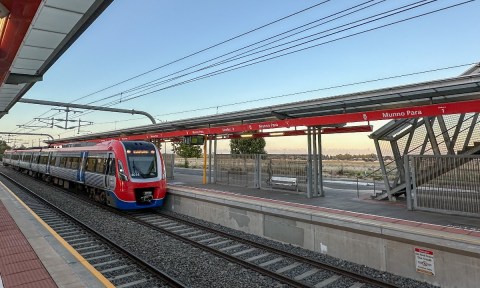Public transport’s lingering COVID hangover
Total patronage of Adelaide’s trains, trams and buses has recovered significantly since the pandemic – but is still more than 10 per cent down on pre-COVID levels.

Data published by the Department for Infrastructure and Transport this week shows the number of trips on Adelaide’s public transport system reached 67,654,498 in the 2023-24 financial year.
The majority of trips – nearly 46.4 million – were made on Adelaide’s bus network, followed by more than 12.3 million via train and 8.8 million on the tram.
Total public transport patronage increased 12.6 per cent on 2022-23 and 42.3 per cent on 2021-22 when it slumped to just 47,529,317 trips amid COVID-era restrictions.
But public transport usage is still around 11 per cent below the last non-COVID-affected financial year – 2018-19 – when patronage reached a high of 76,159,209.
This includes 4.6 million fewer trips by bus, 3.2 million fewer trips by train and 583,011 fewer trips by tram.

Dr Andrew Allan, University of South Australia senior lecturer transport, urban and regional planning, pointed to two trends that have affected Adelaide’s public transport patronage: work from home and increased new car sales.
You might like
“People are also creatures of habit, so they got into this way of doing things – work from home during the pandemic – and it hasn’t bounced back completely,” he said.
Allan said “frequency, reliability, affordability and also quality of service” were key to increasing patronage of public transport.
He suggested a review of Adelaide Metro’s fare structure, including greater incentives for frequent users of public transport, could be a way to encourage modal shift away from cars.

Seventy-one per cent of commuters in Greater Adelaide used a private vehicle to get to work in 2021, according to data prepared for an Infrastructure SA paper last year, compared to just 5.51 per cent who chose public transport.
Allan also said Adelaide’s urban sprawl and propensity towards low-density housing has made the development of public transport more difficult.
“We’ve got this low-density mentality, which is probably easiest to serve with the car,” he said.
“It is hard to serve public transport in those localities where you just don’t have enough of a commuter catchment to make it economically worthwhile, so it becomes more of a welfare function.
Stay informed, daily
“And for some people they don’t like that idea that public transport is not necessarily a quality product and the frequency’s low, and the reliability isn’t great because there’s so much traffic all across the network and it takes a lot longer to get anywhere on the road system on public transport.

“But that tendency to sprawl further and further out makes it all that much harder for a bus-based public transport system.”
Transport Minster Tom Koutsantonis acknowledged the change in work habits has had an impact on public transport usage.
Asked about the latest transport figures, he said in a statement: “It’s fantastic to see commuters continue to return to public transport in significant numbers.”
“We always knew it would be a long way back to pre-COVID patronage levels – particularly with dramatically different work habits that have remained the norm since the pandemic,” he said.
“However, in the last financial year we have seen a more than 7.5 million increase in total patronage – an increase of 12.6 per cent – most notably an almost 6 million increase in bus patronage and a more than one million additional tram passengers.
“This builds on the previous year’s 26.4 per cent increase. That’s two years of consecutive growth, which has been bolstered by our investments in public transport.”
Koutsantonis pointed to a range of state government initiatives on public transport, including the recently opened Port Dock rail extension which he said saw more than 50,000 passengers in its first month of service.
He also said a new T800 bus service between Adelaide and Mount Barker has recorded a daily weekday average of around 2300 boardings which is “a more than 19.3 per cent increase in patronage”.
Seniors card holder travel on public transport has also increased nearly 50 per cent from 2020-21 to 2023-24 – from around 5.1 million trips up to 7.5 million – with the government highlighting its introduction of free all-day travel for seniors card holders in July 2022.
The gradual recovery of public transport patronage comes ahead of the state government reversing the privatisation of Adelaide’s passenger trains and trams next year.
Private operator Keolis Downer’s operation of Adelaide’s six train commuter routes will return to government hands at 3am on February 2, 2025, according to the department’s annual report.
Tram operations, run by Torrens Connect, will return to public hands at 3am on July 27.








